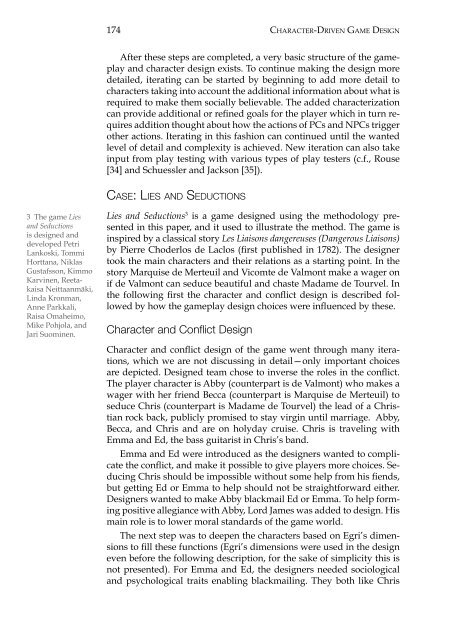Character Driven Game Design
Character Driven Game Design
Character Driven Game Design
Create successful ePaper yourself
Turn your PDF publications into a flip-book with our unique Google optimized e-Paper software.
174<br />
<strong>Character</strong>-<strong>Driven</strong> <strong>Game</strong> <strong>Design</strong><br />
After these steps are completed, a very basic structure of the gameplay<br />
and character design exists. To continue making the design more<br />
detailed, iterating can be started by beginning to add more detail to<br />
characters taking into account the additional information about what is<br />
required to make them socially believable. The added characterization<br />
can provide additional or refined goals for the player which in turn requires<br />
addition thought about how the actions of PCs and NPCs trigger<br />
other actions. Iterating in this fashion can continued until the wanted<br />
level of detail and complexity is achieved. New iteration can also take<br />
input from play testing with various types of play testers (c.f., Rouse<br />
[34] and Schuessler and Jackson [35]).<br />
Case: Lies and Seductions<br />
3 The game Lies<br />
and Seductions<br />
is designed and<br />
developed Petri<br />
Lankoski, Tommi<br />
Horttana, Niklas<br />
Gustafsson, Kimmo<br />
Karvinen, Reetakaisa<br />
Neittaanmäki,<br />
Linda Kronman,<br />
Anne Parkkali,<br />
Raisa Omaheimo,<br />
Mike Pohjola, and<br />
Jari Suominen.<br />
Lies and Seductions 3 is a game designed using the methodology presented<br />
in this paper, and it used to illustrate the method. The game is<br />
inspired by a classical story Les Liaisons dangereuses (Dangerous Liaisons)<br />
by Pierre Choderlos de Laclos (first published in 1782). The designer<br />
took the main characters and their relations as a starting point. In the<br />
story Marquise de Merteuil and Vicomte de Valmont make a wager on<br />
if de Valmont can seduce beautiful and chaste Madame de Tourvel. In<br />
the following first the character and conflict design is described followed<br />
by how the gameplay design choices were influenced by these.<br />
<strong>Character</strong> and Conflict <strong>Design</strong><br />
<strong>Character</strong> and conflict design of the game went through many iterations,<br />
which we are not discussing in detail—only important choices<br />
are depicted. <strong>Design</strong>ed team chose to inverse the roles in the conflict.<br />
The player character is Abby (counterpart is de Valmont) who makes a<br />
wager with her friend Becca (counterpart is Marquise de Merteuil) to<br />
seduce Chris (counterpart is Madame de Tourvel) the lead of a Christian<br />
rock back, publicly promised to stay virgin until marriage. Abby,<br />
Becca, and Chris and are on holyday cruise. Chris is traveling with<br />
Emma and Ed, the bass guitarist in Chris’s band.<br />
Emma and Ed were introduced as the designers wanted to complicate<br />
the conflict, and make it possible to give players more choices. Seducing<br />
Chris should be impossible without some help from his fiends,<br />
but getting Ed or Emma to help should not be straightforward either.<br />
<strong>Design</strong>ers wanted to make Abby blackmail Ed or Emma. To help forming<br />
positive allegiance with Abby, Lord James was added to design. His<br />
main role is to lower moral standards of the game world.<br />
The next step was to deepen the characters based on Egri’s dimensions<br />
to fill these functions (Egri’s dimensions were used in the design<br />
even before the following description, for the sake of simplicity this is<br />
not presented). For Emma and Ed, the designers needed sociological<br />
and psychological traits enabling blackmailing. They both like Chris
















